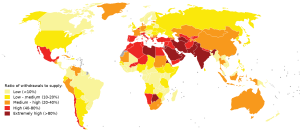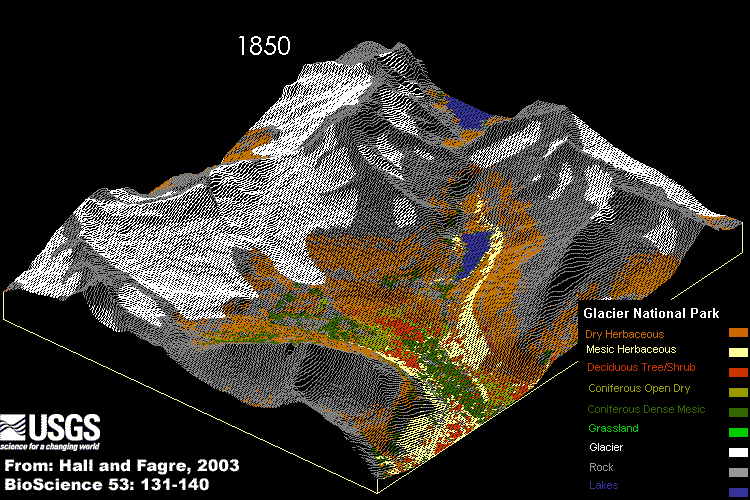5
By Katherine Corbin, Elizabeth Dalberg, and Gabriel Ward
Introduction: Climate Changes Impact on Water Resources
As evidence of climate change becomes increasingly abundant, one critical aspect of our lives that will be affected is our water resources. These resources are greatly impacted by pollution caused by climate change. Glaciers have already seen massive decreases in net mass, putting many communities that rely on melt water from these glaciers to put at risk of losing their drinking water. In addition to this, many desert regions have been affected by the loss of water. Droughts are increasing and many regions have been experiencing shortages of water (Figure 1). The limitations of water have also affected the agriculture production which countries rely on for their economy.
Water Scarcity
Regions around the world are facing water scarcity and droughts. Cape Town, South Africa, is in a water crisis because of a severe three-year long drought which has caused water to be rationed. Cape Town is at a point where they have reached “peak water”. This means that they have safely reached the amount of water that can be taken from the area. If the drought persists, Cape Town will reach “day zero” when millions of homes will have no running water (Leahy, 2018). The regions rely on the stability of the climate water cycle. Climate change has disrupted the Earth’s water cycle affecting how much rain falls, where it rains, and when it rains. The atmosphere is warming the planet, which is increasing the absorption of water from the soil. The absorption of water is affecting regions where rain belts and deserts have shifted and changed the amount of water for each region (UCAR Center for Science Education). In 2015, São Paulo, Brazil reached its own “day zero”, where they had to shut off water systems for 12 hours forcing businesses and industries to shut down (Leahy, 2018). The atmosphere is absorbing water faster than the water cycle can produce enough water for Brazil’s economy to function. Barcelona, Spain in 2008 had to import freshwater tanks from France. All over the world people are experiencing more frequent water scarcity and droughts because of climate change (Figure 1). In the southwest of the United States, increasing droughts are creating more wildfires and affecting livestock and crops. The warming temperatures will evaporate the water that is left in the ground creating drier soil, and worsening wildfires (Center for Climate and Energy Solutions, 2020). The increase of carbon dioxide and water vapor in the atmosphere has warmed the Earth and shifted the rain belts. The regions that do not have the rain belts are seeing an increase of water absorption from the soil, and no rain to stop the soil from becoming dry. This is happening a lot in Eastern Africa, Southwestern United States, Australia and many more places (Figure 1).

Solutions for Water Scarcity
Crops will be more tolerant to heat and water stress, and soil management practices will lead to higher quality soil retention (Marshall et al., 2015). A simple solution to this problem, is to grow water intensive crops in water intensive regions, and vice versa. Water intensive crops need tons of water to be able to grow and produce. A possible solution to water scarcity is reusing treated wastewater. This has shown to be a cost-effective solution (Leahy, 2018). Other short-term solutions to stop water scarcity are conserving water, more efficient water usage throughout industries, alternative water supplies, adding in green infrastructure for stormwater management, and having plans in place for water in emergency droughts. A more suitable and longer lasting solution, however, would be to curb greenhouse gas emissions (Center for Climate and Energy Solutions, 2020).

Melting Glaciers
In addition to African and other desert communities experiencing increased droughts, communities surrounding mountain ranges will be subject to significant changes in their water supply. These changes are caused by the increasing loss of mass in glaciers located around mountain ranges such as the Himalayas, the Rocky Mountains, and the Andes. In a study analyzing the effects of increased glacial melt in the Rocky Mountains, glaciers have lost 259 +/- 28 Gt/yr from 2003 to 2009. 78% of the meltwater produced from these glaciers flows west of the mountains into the Pacific Oceans, while the remaining 22% flows east into the Arctic Ocean and Hudson Bay. This contributes to about 0.72 mm +/-0.08mm sea level rise per year (Castellazi, 2019). Projections for the future raise some significant concerns, as by the next century it is predicted that glaciers in the Canadian Rocky Mountains will have lost 90% of their mass (Castellazi, 2019). Figure 2 displays past glacial ice melting as well as projections for the future in Glacier National Park, located within the Rocky Mountains in the US. The impact this will have on communities surrounding these mountain ranges is extremely difficult to predict due to the complexity of groundwater and surface-water interactions. Monthly discharge projections range from 23% to 518% of current discharge amounts from glaciers (Buytaert et al., 2009). This extreme amount of variability is concerning, as these changes could have drastic effects that will impact the way of life in those surrounding communities, including increased flooding, damage to crops, and less snowpack, or minor effects that may go unnoticed.
Glaciers provide a reliable source of drinking water during dry periods and warm months. Glacier drainage basins cover 26% of the global land surface outside Greenland and Antarctica, which are covered in ice sheets. These basins are populated by 1/3 of the world’s population (Davies, 2020). Meltwater that flows downstream from glaciers is used for various critical aspects of society that include irrigation, hydropower, ecosystems, and of course drinking. Meltwater from these glaciers acts as a vital supplement to other water resources during droughts and low streamflow (Davies, 2020). As glaciers continue to shrink at an alarming rate, annual meltwater increases until “peak meltwater” is reached. At this point, runoff decreases since the decreased volume of the glaciers can no longer support the increased meltwater. In many basins that rely on meltwater during droughts, peak meltwater is projected to be reached in the next 20-30 years. This means that half the worlds population could be living in water scarcity by then (Davies, 2020).
Water Pollutants
Climate change has greatly impacted water resources, causing them to become polluted. Chemical pollution has had significant ramifications on water resources as inorganic and organic micropollutants including metalloids, toxic metals, and a variety of synthetic organic chemicals have polluted water supplies. The most relevant sources impacting water pollution include geogenic pollutants, mining operations, and hazardous waste sites. Pathogens are also present in these polluted waters significantly impacting human health as a lack of safe drinking water currently affects more than a third of the people in the world (Schwarzenbach et al., 2010). Water resources have also been significantly impacted by the absorption of CO2 into the hydrosphere causing the pH levels of the oceans to decrease, making the water more acidic (Barford, 2013). The pollution of water on Earth has greatly impacted societies as pollutants and pathogens that are present in water supplies has left people without clean drinking water.
Solutions to cleaning polluted water
Fortunately, there are solutions that can be used to clean water resources, one of which being nanotechnology. Nano and micromotors can perform many forms of specialized tasks, including cleaning polluted waters. These motors can move around and mix contaminated water, increasing the interaction between active sites and target pollutants. The active sites that are present remove the pollutants that are being targeted from the water resources. This form of treatment is cost and time effective. The removal mechanisms used in nanotechnology absorb the organic pollutants, toxic metals, and oil pollutants that are present in polluted water systems. The organic pollutants are removed through degradation (Eskandarloo et al., 2017). The use of this technology will greatly help water resources leaving a positive impact on society.
Conclusion
Overall, water resources on Earth have been greatly impacted by climate change and pollution. This damage comes with a large societal cost, as these water resources play a significant role in our well-being. Water scarcity and droughts have become a large problem leading to drastic effects on the agricultural industry. Glacier melting has also impacted groundwater resources in the form of excessive discharge and an unprecedented amount of mass lost. In addition to curbing the drastic changes in our water systems, maintaining and improving cleanliness in our water supplies should be a top priority. A technology that could be useful in this nanotechnology. Nanotechnology is a cost and time effective tool that could significantly help water supplies. Water resources play an important role in society, and they should be maintained.
References
Barford, E. (2013). Rising ocean acidity will exacerbate global warming. Nature. https://doi.org/10.1038/nature.2013.13602
Buytaert, W., Célleri, R., & Timbe, L. (2009). Predicting climate change impacts on water resources in the tropical Andes: Effects of GCM uncertainty. Geophysical Research Letters, 36(7), L07406–n/a. https://doi.org/10.1029/2008GL037048
Castellazzi, B., Burgess, D., Rivera, A., Huang, J., Longuevergne, L., & Demuth, N. M. (2019). Glacial melt and potential impacts on water resources in the Canadian Rocky Mountains. Water Resources Research, 55(12), 10191–10217. https://doi.org/10.1029/2018wr024295
Center for Climate and Energy Solutions. (2020). Drought and climate change. Retrieved from http://www.c2es.org/content/drought-and-climate-change/
Eskandarloo, H., Kierulf, A., & Abbaspourrad, A. (2017). Nano- and micromotors for cleaning polluted waters: focused review on pollutant removal mechanisms. Nanoscale, 37, 13850-13863. https://pubs.rsc.org/en/content/articlepdf/2017/nr/c7nr05494g
Fecht, S. (2019, September 23). How climate change impacts our water. Columbia Climate School. Retrieved from https://blogs.ei.columbia.edu/2019/09/23/climate-change-impacts-water/
Hall, M. H. P., & Fagre, D. B. (2003). Animation of modeled climate-induced glacier change in Glacier National Park, 1850- 2100. USGS (US Geological Survey). Retrieved from https://upload.wikimedia.org/wikipedia/commons/c/c0/Glac_modelled_glacier_change_animation.gif
Leahy, S. (2018, March 22). From not enough to too much, the world’s water crisis explained. National Geographic. Retrieved from https://www.nationalgeographic.com/news/2018/03/world-water-day-water-crisis-explained/
Marshall, E & Aillery, M. (2015). Climate change, water scarcity, and adaptation. United States Department of Agriculture ERS (Economic Research Service). Retrieved from https://www.ers.usda.gov/amber-waves/2015/november/climate-change-water-scarcity-and-adaptation/
Schwarzenbach, R. P., Egli, T., Hofstetter, T. B., von Gunten, U., & Wehrli, B. (2010). Global water pollution and human health. Annual Review of Environment and Resources, 35, 109-136. https://doi.org/10.1146/annurev-environ-100809-125342
UCAR Center for Science Education. The water cycle and climate change. University Corporation for Atmospheric Research. Retrieved from https://scied.ucar.edu/longcontent/water-cycle-climate-change
